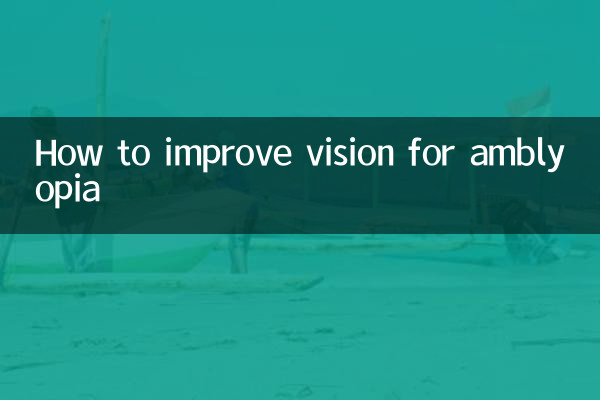How to improve vision for amblyopia
Amblyopia (commonly known as "lazy eye") is a common vision problem in children that can also affect adults. In recent years, with the improvement of health awareness, the treatment of amblyopia and vision restoration methods have become hot topics. This article will combine the hot content of the entire Internet in the past 10 days to provide you with a detailed analysis of the causes, treatment methods and daily care suggestions for amblyopia.
1. Causes and classification of amblyopia

Amblyopia is usually caused by the eyes not receiving clear image stimulation during the critical period of visual development (0-6 years old). Depending on the cause, amblyopia can be divided into the following types:
| type | Proportion | Main causes |
|---|---|---|
| refractive error amblyopia | 50%-60% | High farsightedness, astigmatism or myopia |
| strabismic amblyopia | 20%-30% | Both eyes cannot look at the target at the same time |
| deprivation amblyopia | 10%-20% | Congenital cataract, ptosis, etc. |
2. The latest treatment methods for amblyopia
According to recent hot discussions in the field of ophthalmology, the treatment of amblyopia needs to develop a personalized plan based on age and cause:
| Treatment | Applicable age | efficient | Course of treatment |
|---|---|---|---|
| Covering therapy | 3-12 years old | 70%-80% | 3-6 months |
| atropine depression therapy | 3-10 years old | 60%-70% | 6-12 months |
| visual training | 6 years old+ | 50%-60% | long-term persistence |
| Digital therapy (gamified training) | 4 years old+ | emerging methods | Effective in 4-8 weeks |
3. New trends in improving amblyopia in adults
Recent research shows that amblyopia in adults is not completely irreversible. The following are methods for improving amblyopia in adults that are hotly discussed across the Internet:
1.neuroplasticity training: By stimulating the visual cortex of the brain through specific visual tasks, a recent study showed that 30% of adult patients' vision improved by 1-2 lines.
2.Binocular vision function training: Binocular coordination training using VR technology has become a hot topic, and many hospitals have launched clinical trials.
3.nutritional supplement therapy: Attention to supplements with eye-protecting ingredients such as lutein and zeaxanthin increased by 30%.
4. Daily eye protection essentials
Based on recent recommendations from ophthalmologists, patients with amblyopia should pay attention to:
| matter | suggestion | scientific basis |
|---|---|---|
| Eye time | 20-20-20 rule | Look 20 feet away for 20 seconds every 20 minutes |
| Lighting conditions | 500lux and above | Prevent the progression of myopia |
| Dietary supplements | Vitamin A/C/E | Protect retinal health |
5. Clarification of common misunderstandings
1."Amblyopia will naturally get better when you grow up.": Totally wrong! The cure rate drops significantly after the age of 12, and early intervention is needed.
2."You will become dependent on glasses after wearing them for a long time.": This is necessary optical correction. Failure to wear it will aggravate amblyopia.
3.“Surgery can cure amblyopia”: Surgery only solves problems such as strabismus, and visual training is still required after surgery.
6. Latest research progress
1. Gene therapy: Clinical trials targeting specific hereditary amblyopia have entered Phase II.
2. Transcranial Magnetic Stimulation: Non-invasive brain stimulation technology showing potential in small-scale trials.
3. Artificial Intelligence Screening: Multiple AI vision screening apps have an accuracy rate of over 90% and are suitable for early detection.
Summary: Amblyopia treatment needsEarly detection, early intervention, and consistent treatment. The golden treatment period for children is between 3 and 6 years old, and adults can also improve their vision through emerging methods. It is recommended to have a professional vision examination every 3-6 months and develop a personalized plan based on the doctor's advice.

check the details

check the details